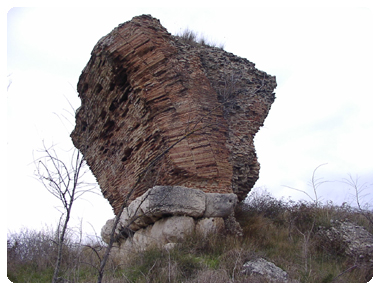 |
It is a bridge
pier with only the fastening of the arch spans sticking out of it. The
ruin is also called the Devil’s bridge, as it was once narrated in a
hagiographic tale how, among other things, the Devil built and destroyed
it in just one night’s time, by black magic. All around the tall and
uneven pier there aren’t to be seen human dwellings, so the solitary and
gullible night wayfarers who could not avoid passing by were really seized
by terror looking at it.
The truth is that the pier is the only remain of a Roman bridge which,
like the other one called
“Ponte delle
Chianche”, in Buonalbergo territory stood once along the Trajan
Road, built at the beginning of the II cent. A.D. The road linked
Benevento and Brundisium more easily than the more ancient Appian Road
which crossed the Apennine through Aeclanum. The Santo Spirito Bridge was
probably longer and higher than the Chianche Bridge, as it had in this
case to span a river and its steep banks, the Miscano.
Among the cobble stones of this river bed, which today is almost dry all
the year round, it was found, some decades ago, a milestone whose
dimensions were unusually large, Quite certainly that met the epigraph
purpose, because it informed also about the patron of the work in a
celebratory way.
What remains of the tablet is now to be found at Malvizza di Sopra, but
its original site was probably at one of the bridge ends.
But as it can be judged from our photos what remains of the epigraph is
almost nothing. However, “-ONTES” was probably PONTES (“bridges”), and
“BRVNDISIVM” the final destination of the road, so we advance as a
hypothesis that the inscription informed about all the bridge built all
along the entire Trajan Road and the authority that built them. “–(I?)A –
SVA” we reconstruct as PECVNIA SVA (“with his money”); and “P - P” as
“Pater Patriae” (Father of the Fatherland”), which is one of Trajan’s
official titles that can be read in the dedicatory inscription of the
Trajan Arch of Benevento, the gate of the road.
On the other hand, who could finance that road, with its bridges, arches,
etc. if it was not the munificent M. Ulpius Nerva Traianus, who is remembered as
the most profligate builder in the imperial times of grandiose and
beautiful monuments, in Rome and in many other places? Because of the
immense expenses he encountered he risked almost a financial default, even
though he was the emperor.
We didn’t succeed in ascertaining whether the epigraph has ever been
registered in the Corpus Inscriptionum Latinarum (C.I.L.)(Sect. n. ) |

